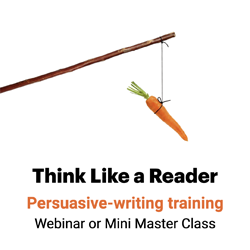‘Say goodbye to the 60-hour workweek’
You know that the topic is never the topic: The reader is the topic.

You’ve acknowledged that readers don’t care about “us and our stuff”; they care about themselves and their needs. You buy into the notion that the first thing your reader wants to know about your message is WIIFM, or What’s In It For Me.
Now what?
The next step is to find some great WIIFM copy to model. And have I got a piece for you. Here’s Briefings Publishing Group’s promo for a how-to video. The WIIFM copy is well worth modeling.
Here it is — with, of course, my notes:
Say Goodbye to the 60-hour Work Week
The headline starts with the imperative voice — aka the implied “you.” That’s great.
Plus, it’s specific. Not “long hours at the office,” but “the 60-hour work week.” Don’t forget to quantify and specify your own marketing copy.
Here, we move back from the second person to the third. Not a great choice.
A braver, more benefits-oriented approach would be to speak directly to “you,” as in, “You can’t do your sharpest, most creative work when you’re burned out …”
It’s a smart choice to lead with the problem in the first paragraph and follow up with the solution in the second.
But instead of moving into first person plural (“we’ve created”), keep focusing on the reader (“Now you can make time to relax and recharge and ensure that your time spent in the office is creative and productive with our new video …”)
The second sentence is a masterpiece of you-focused benefits writing.
- How to liberate yourself by identifying and tossing out the non-essentials.
- How to be ready with these “enders” when you’re trapped in a never-ending conversation.
- How to make a lifechanging “DON’T Do List.”
- How to become a pro at exercising your ability to just say “No.”
- How to get out of the office using the “quitting time buddy system.”
- How to streamline and focus the two most critical work systems.
- How to avoid the temptation to multitask, and much more!
This is a nice list of benefits, but a verb list would highlight the WIIFMs more effectively — and unload 14 words in repeated “How to’s.”
To create a verb list, set up the “how to” in the intro to the list: ” … you’ll discover tips and tactics guaranteed to help you free up your time and get your life back, including how to:”
Now you can start each bullet with a verb. See how much stronger this list is with bullets that begin “Liberate,” “Streamline” and “Avoid.”
Guideline: Start your lists with verbs whenever possible. It will condense your copy, activate your language and bring the benefits to the front of your list. Here’s how it works:
- Liberate yourself by identifying and tossing out the non-essentials.
- Free yourself from never-ending conversation by using these “enders.”
- Make a lifechanging “DON’T Do List.”
- Become a pro at exercising your ability to just say “No.”
- Get out of the office using the “quitting time buddy system.”
- Streamline and focus the two most critical work systems.
- Avoid the temptation to multitask.
- And much more!
All right: You’ve got your model; now use it. Reach more readers and sell more ideas when you write in WIIFMs, not about “us and our stuff.”

Leave a Reply